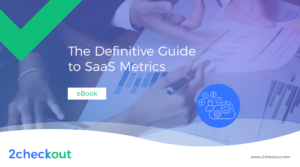Updated in March 2023
In the SaaS industry, business performance is measured in relatively new ways and constantly evolving as eCommerce grows and expands. Acquiring customers, onboarding them, increasing their revenue stream, and convincing them to stick around: all are challenges that SaaS businesses face every day.
Subscription-based businesses face unique challenges. There are no one-off transactions in SaaS—it’s all about maximizing the lifetime value of customers and keeping them happy month after month, year after year.
Metrics are powerful because they describe exactly how well your SaaS business is currently performing—and how it’s likely to perform in the future. They provide actionable feedback that lets you improve the full customer experience:
- Acquisition
- Onboarding and activation
- Monetizing customers
- Renewal and retention
In every product category, competition is typically fierce. In our eBook, The Definitive Guide to SaaS Metrics, we explore the critical metrics for understanding your company’s success, strengths, and weaknesses. These metrics give you a platform for building better customer & product experiences and driving your business in the right direction—consistently and with great success.
Customer retention is vital to the overall health of your SaaS business; it will be what drives your company’s growth and ensures stability, not just from recurring revenue but also from word-of-mouth recommendations that lead to new accounts.

Let’s take a quick look at some of the most essential retention metrics.
Customer churn rate

Customer churn is a crucial metric for any SaaS company. It illustrates the level of engagement and commitment from your customers over the short and long term. In other words, it puts a number on loyalty.
But high churn doesn’t always mean there’s a problem. You have to put the number in context. Some industries—for example, email marketing, where customers may churn if they fail to get results, which is outside your platform’s control—are naturally higher-churn.
Calculating customer churn rate is straightforward:
Churn rate = (# of churned customers / total initial # of customers) for a given period of time.
This will help you see how churn fluctuates over time and understand why your customers are leaving.
However, churn rate can also be analyzed from a financial perspective. Churned revenue is the revenue that a business loses due to customer churn. It represents the amount of revenue that would have been generated if the churned customers had continued to renew their subscriptions. Calculating churned revenue is important because it helps businesses understand the actual impact of customer churn on their revenue and profitability.
Reducing churned revenue can be challenging, but it is essential for the long-term sustainability of a business.
Customer retention rate
This is a measure of how many customers keep subscribing to your product over time. It is one of the most important retention metrics examples.
Retaining current customers is essential for every single SaaS provider. There are significant reasons why:
- It can cost your business five times more to acquire a new customer than to keep an existing one.
- By increasing customer retention by just 5%, businesses can boost profits by anywhere from 25% to 95%. When customers are happy and engaged, they are less likely to cancel their subscription, resulting in reduced churn rates and increased revenue.
- Repeat customers will spend, on average, almost 70% more than your new customers
Customers who feel valued and appreciated are more likely to become brand advocates and promote your product to their friends, family, or colleagues. By building strong relationships with customers and delivering an exceptional customer experience, you can turn your customers into loyal advocates that drive additional revenue through referrals and positive word of mouth.
But high retention also validates your product and marketing activities. It validates the product because people keep using it and paying for it—it’s that simple.
But it also shows you’re targeting the right prospects with effective marketing. If you were generating lots of signups but quickly losing those customers, the clear conclusion is that your product didn’t actually solve their problem.
How to calculate retention rate: (total customers – new customers) / old customers.
Customer renewal rate

How many of your customers renew their subscriptions?
This metric seems simple, but it’s more subtle than you think. Consider:
- What is the subscription period?
- Is renewal automatic?
Your goal should be to encourage annual, automatic renewals. The reason is that monthly renewals make customers question their decision 12x per year—a huge point of friction. And, of course, automatic renewals, while they may generate more refund requests, tend to increase retention.
This metric is invaluable not only because it ties directly to profitability but because customer reactions to renewal requests say a lot about their belief in your product.
Cost-to-service (CTS)
How much does it cost to provide your services? We’re looking at the following:
- Hosting
- R&D
- Tech support
- Onboarding
- Account management
- Promotions & retention costs
These costs are often overlooked or not highly visible but can quickly outgrow your actual subscription revenue if you’re not careful. This is a particular concern for small or emerging SaaS platforms—they don’t have a robust customer base or economies of scale to increase margins.
By maintaining a running CTS, you will better understand your operating margin and be able to price your subscriptions appropriately.
Calculate CTS by adding all the up-mentioned costs for a given period.
Customer Lifetime Value (CLV, CLTV, or LTV)
How much revenue will each customer generate over their entire relationship with your brand?
This is a powerful metric because it contributes to a high-level health check on the business. It does so by providing a clear picture of the long-term value of the customer base.
Unfortunately, CLTV is not easy to calculate. First, we must estimate the average customer lifespan and determine the ARPU and acquisition costs. A more reliable formula will include complex variables like revenue expansion over time.
Thankfully models and calculators exist to make these calculations on your behalf. CLTV may be complicated, but it’s among the most crucial metrics for SaaS businesses.
Customer engagement score

How engaged are your customers?
There is no business for which engagement is more crucial than SaaS. If users regularly use and get value from your product, they will continue using it.. Your revenue stream dries up with it.
The customer engagement score is often presented as a percentage or number out of 10. It is hard to calculate (“engagement” is a complex and multifaceted concept), but modern data analytics tools do a great job.
Why is the engagement score important?
- Highly engaged customers are very likely to renew and use your product
- Unengaged customers are likely to churn
SaaS companies can target unengaged customers before they churn and try to win them round. That’s one reason why engagement scores are significant.
Gross MRR churn rate
Your customers are going to switch between tiers. Unfortunately, much of that trajectory will be downward. The Gross MRR churn rate measures the percentage of revenue lost to canceled or downgraded subscriptions.
It’s interesting, but why is it important?
Because it points very clearly to an issue with your pricing tiers:
- Is your flagship tier failing to justify the price?
- Are you targeting prospects that only need basic functionality?
- Is your product over-engineered?
- Did customers join a higher tier as part of a promotion?
Use the gross MRR churn rate to understand how customers perceive your subscription tiers. Then get to work lowering the number!
Net MRR churn rate

Net MRR churn rate takes things a step further. It factors in expansion and contraction revenue:
- Expansion revenue is when customers upgrade or purchase additional products or services.
- Contraction revenue is the opposite. Revenue lost due to canceled or reduced subscriptions.
This is an essential metric to understand the health of your SaaS business and to determine whether your business model is sustainable. It is calculated as a percentage and should be as close to 0% as possible.
It’s even possible to reach a negative net MRR churn rate. This means your company is generating more revenue from customers than it’s losing—an extremely healthy and sustainable position.
Volume of support tickets
How many support tickets are generated every month? How many are closed? How fast?
Monitoring the volume of support tickets helps SaaS businesses to identify trends among customers. It highlights key pain points and gives you direction for how your product could be improved. These insights can inform the product development roadmap.
Any trends in the volume of support tickets—e.g., a spike in demand after new product updates or large promotions—can also be used to manage the schedule and workload of support agents.
The vast majority of helpdesk software will provide this data in an easy-to-read format, like a digital dashboard.
Net Promoter Score (NPS)
This is a pulse check on how satisfied your customers are. Specifically, it measures how willing your customers would be to recommend your brand or product to a friend or colleague.
- A high score means they’re likely to promote
- A low score means they aren’t
As with all metrics, the value here isn’t just knowing you have a happy customer base. It’s about seeing what work’s required to turn more customers into advocates.
The calculation is easy. Simply email customers and ask: On a scale of 1 to 10, how likely are you to recommend our products?
Those numbers are your Net Promoter Scores.
Dive deeper into these metrics, and more, with our eBook, The Definitive Guide to SaaS Metrics. You’ll learn how to calculate each metric and use that information to drive more retention, lower churn, and ultimately increase company success and profitability.






